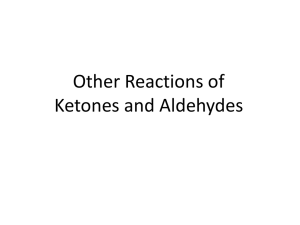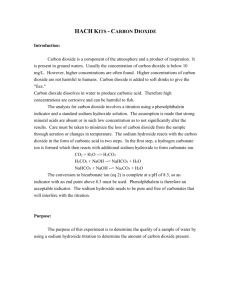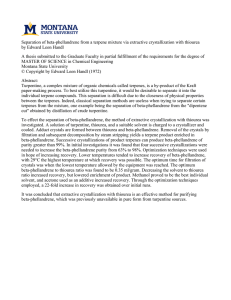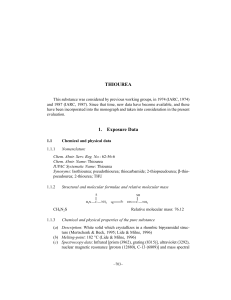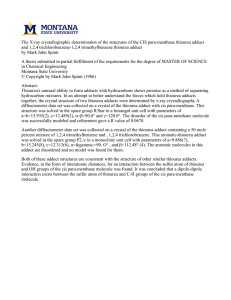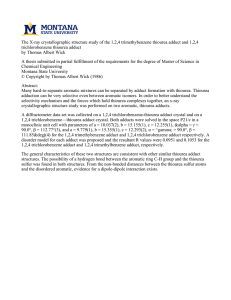reduction of crganic compounds with thiour
advertisement
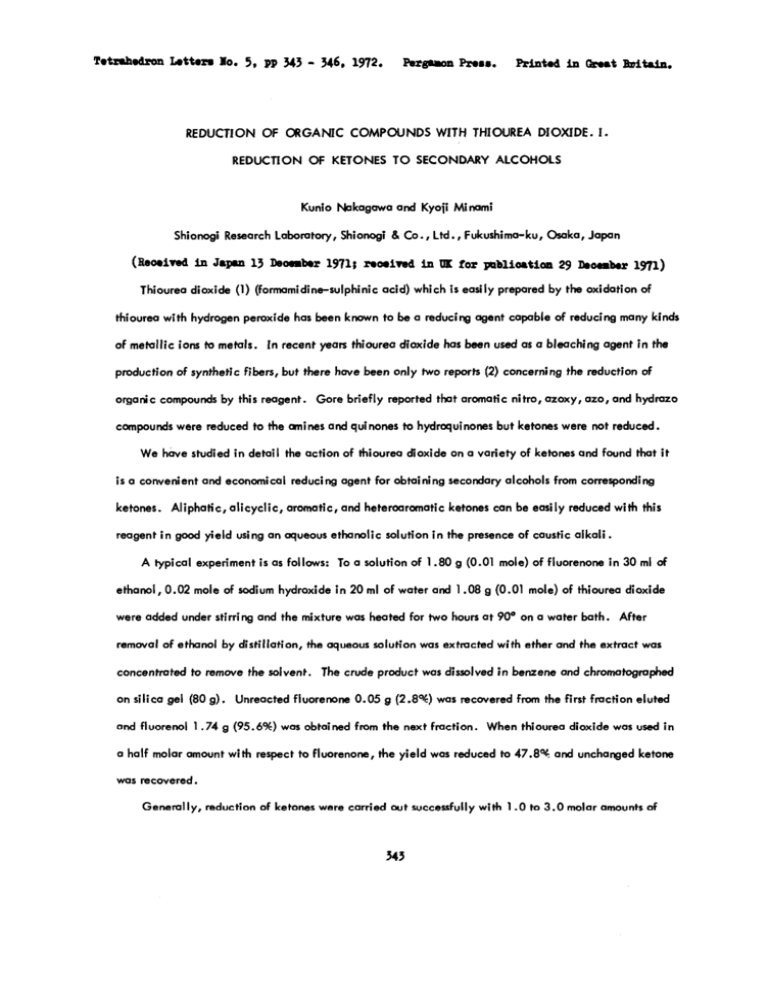
TotmhedronLetton lo. 3, pp 343 - 346,1972. Pergamn Psr.88. printed In eo8t Bzitaill. REDUCTION OF CRGANIC REDUCTION Shionogi (boei=d Thiourea thiourea Research Labomtory, Shionogi dioxide 13 Wbor peroxide ions to metals. production of synthetic We have studied ketones. Aliphatic, reagent in gocd yield A typical ethanol, 0.02 alicyclic, experiment concentrated on silica and fluorenol 1.74 aromatic, briefly ALCOHOLS Fukushima-ku, is easily Osaka, prepared to hydrcquinones dioxide on a variety and heteroaromatic ketones solution was heated for two hours at 90* was obtained not reduced. from corresponding reduced of caustic with in 30 ml of mole) of thiourea on a water bath. dioxide After in benzene was recovered the yield was reduced thiourea to 47.8Sr: was ond chromatogmphed from the first fmction When this alkali. was dissolved g (2.8%) of and hydrazo with ether and the extract from the next fmction. to fluorenone, azo, was extracted The crude product 0.05 agent in the mole) of fluorenone g (0.01 many kinds of ketones and found that it can be easily g (0.01 and 1.08 azoxy, alcohols in the presence of 1.80 in 20 ml of water nitro, of the reduction but ketones were secondary fluorenone respect that aromatic 1~1) of reducing has been used as a bleaching reported the aqueous solution the solvent. Japan by the oxidation agent capable agent for obtaining and the mixture Unreacted a half molar amount with which To a solution is as follows: g (95.6%) Ltd., dioxide of thiourea reducing by distillation, to remove gel (80 g). thiourea Gore mole of sodium hydroxide of ethanol II, Co., acid) using an aqueous ethanolic were added under stirring removal yean the action and economical I. and Kyoii Minami to the amines and quinones in detail SECONDARY DIOXIDE. but there have been only two reports (2) concerning compounds by this reagent. compounds were reduced THIOUREA has been known to be a reducing fn recent fibers, WITH l971;nooivud inu~ rorplruioation 29 tiou& (1) (formamidine-sulphinic with hydrogen is a convenient TO Nakagawa of metallic organic KETONES Kunio Jw- ia. OF COMPOUNDS dioxide eluted was used in and unchanged ketone was recovered. Genemlly, reduction of ketones were carried out successfully 343 with 1 .O to 3.0 molar amounts of lo. thiourea dioxide using sodium hydroxide reaction mixture, Considering almost theoretical these resulk, in twice molar amounts to that of the reducing amounts of sodium sulphite this reaction + The reducing power of thiourea with thiourea dioxide Reduction by-products. a dimer, For example, for example dioxide proceeded agent was employed, alcohol gz2.0033, aH = 3.3G spectrum was identical Considering tmnsfer reduction ta take place agent of aliphatic occasionally resulted ketones, in the reaction of the reagent of the ketone or di-n-propyl of the alcohol when more reducing portions, the yield of the proceeded through a radical solution showed the presence aH = 2.6G (2H), oH = 0.7G on reduction the reduction way in Table. it becames clear frcm ESR studies and fram the reaction reaction ESR studies on the of the corresponding (2H), with Rongalit and aH = 0.4G of the secondary onion mdical, (2H). This ESR (NaHSQ.CH20.2H20). may possibly be explainable of formation path. in terms of a one electron alcohol of of its side chain gave a poor yield into seveml yield in the formation cleavage However, of fluorenone 36%. resulted methylnonyl mixture. divided in yield in partial slower rate and the reaction of fluorenane, and the mechanism in the following by alkali of benzoylacetone with that obtained these results, but the reduction as a by-product of ketones were summarized in alkaline (2H), by excess of alkali, sq-- increased. that the reaction of fluorenone decomposed at a noticeably In the course of the reduction products obtained + in a molar ratio of 1 : 1 did not give a satisfactory The reduction and the addition was morkedly ,c=o + C 9,9’-bifluorenonel-9,9’-diol, of the reducing The results of the reduction reduction )CH~H was not affected the reduction carbinol. owing to decomposition secondary e of ketones which are easily to give phenylmethyl ketone 2OH- and sodium hydroxide but afforded scheme. ‘WJ, )c=o + HZN\ ,C-SQ- alcohol, From the and urea were obtained. is presumed to be in the following + agent. ond the dimer is presumed 5 Table Reaction Ketone time (hr) Molar (thiaurea mtio dioxide to ketone) Yield 06) Fluorenone 2 1 .o 95.6 Benzophenone 6 1.8 100.0 6 1.8 99.0 Acetophenone 6 1.8 l94.4 Propiophenone 6 1.8 l93.3 Di benr yl ketone 2 1.8 96.7 Reruylmethylketone 6 1.8 l 3-Benzoylpyridine 6 1.8 100.0 8-Acetonaphthone 6 2.4 91 .l a-Methylaminoacetophenone 2 3.0 78.0 Cyclohexonone 6 1.8 80.9 Methylnonylketone 7 2.4 *74.2 Di-n-propylketone 6 2.4 ‘75.5 Desaxybenzoi l Yields n were determined a) All b) Sodium hydroxide reduction by quantitative were done in dilute gas chramatagraphy. alcohol solution ot 90’. was used in twice molar amount of thiourea dioxide. 97,3 Ilo. 5 REFERENCES 1. B. Banett, 2. S. Takagi, l9& 1355. J. Chem. Chem. Soc.,g,63 Pharm. Bull. (1715). (Japan), U.S.P. ,615 2,150,921, (1957); 2,347,446, P. H. Gore, 2,783,272. Chemistry 8, Industry,






